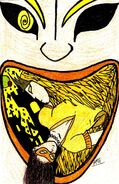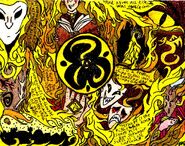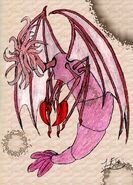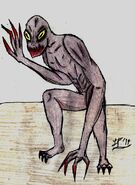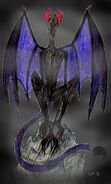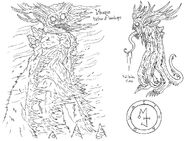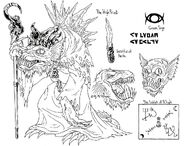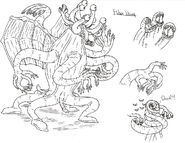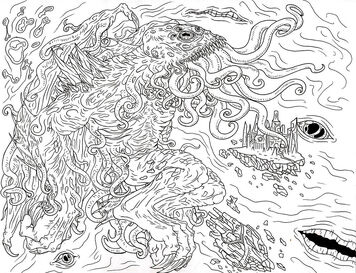
The man himself as drawn by demongirl99
The Cthulhu Mythos is the name for a body of work set in motion by H. P. Lovecraft. Lovecraft's stories (often called "weird fiction" or "Lovecraftian fiction") featured strange deities from beyond the stars that painted a very bleak view of humanity. The ability of humans to fight against the Great Old Ones or the Outer Gods was slim to none. Lovecraft's stories became more popular in spite of this, and other authors contributed to the loose shared universe (named after the short horror story "Call of Cthulhu"). Lovecraft's stories rarely shared the same creatures, but there were references to the same things (like the Necronomicon and Miskatonic University), so it could be inferred they took place in the same world.
Influence on the Fear Mythos
The Cthulhu Mythos is a big influence on the Fear Mythos, especially the later comic book series Fall of Cthulhu, which served as the inspiration for The Great Game. Two specific works that take much from the Cthulhu Mythos are In The Shuffling Madness, which is similar to the Cthulhu Mythos in terms of mood, atmosphere, and themes, and Mephi, which actually combines the two Mythoi into a single continuity and uses elements from both. Many entities from the Cthulhu Mythos also play a significant role throughout OH GOD THE RAPTURE IS BURNING.
The Tarantella manifesting as a meme that works through a symbol or word was inspired by The Yellow Sign, a reoccurring symbol associated with Hastur and his King in Yellow avatar.
Lovecraft Mythos Entities
Great Old Ones
The Great Old Ones are not true gods, but alien beings from the outer reaches of reality whose very nature makes them practically omnipotent in comparison to us. They are, essentially, Sufficiently Advanced Aliens. Lovecraft himself only created the most famous of the Great Old Ones, Cthulhu. The rest of them were added to the mythos later by various other authors.
- Cthulhu: One of the Great Old Ones, Cthulhu and his spawn are semi-aquatic creatures which are neither fully matter nor energy and ruled Earth in aeons past. They wait in the sunken city of Rl'yeh, neither dead nor alive, waiting for the stars to align so that they can return to the surface and rule over the world once more in an orgy of ecstasy, madness, and destruction.
- Ghatanothoa: The first-born spawn of Cthulhu, Ghatanothoa is a massive, amorphous mass which is so hideous that any who look upon it are instantly petrified but remain fully aware of their surroundings. It is currently imprisoned under Mount Yaddith-Gho in the sunken continent of Mu.
- Yig: A serpent-god who can take many forms, Yig formerly ruled over the American continents with an army of followers kept in line by his snake-minions.

Hastur drawn by DarkShadows
- Hastur: Also known as The Unspeakable One and Him Who Is Not to be Named, Hastur is quite possibly the least understood of the Great Old Ones in the Mythos. Originally described as a benign patron god of shepherds, he would later be associated with more negative concepts like decadence and nihilism. He is commonly portrayed as a memetic entity that influences writers, artists, and musicians into creating deranged pieces about him so he can infect more minds. Because of this, Hastur has been described as anything from a person to a place, an object (such as The Yellow Sign glyph), and a deity. He is also connected to Carcosa, a mysterious, ancient, and cursed city located on the shores of Lake Hali in the Hyades star cluster. His most famous avatar is The King in Yellow, a gigantic, masked human-shaped "thing" wearing tattered yellow robes. Said avatar is linked to the fictional play of the same name, a tragedy whose contents are so disturbing it renders anyone who reads it completely insane.
Outer Gods
The Outer Gods are true gods, forces of the universe given shape. They are all omnipotent, or so very nearly so as to make no difference to us. Against them, no defense is possible.
- Azathoth: The blind mad idiot god that dwells at the center of existence, Azathoth is depicted in Lovecraft's works as omnipotent but mindless, the most powerful of the Outer Gods, the ruler of all creation, and the source from which everything in the universe flows. Like many other powerful deities throughout the mythos, the "Dameon Sultan" is said to be trapped in a never ending slumber, lulled to sleep by the accursed flutes and maddening drums of the innumerable servitors of the Outer Gods. The entire cosmos and every living creature within it is, from the ancient bacteria that gave way to life on Earth to the Outer Gods themselves, are nothing more than the dreams of Azathoth and will be wiped from existence the moment he awakens.
- Nyarlathotep: The "soul of the Outer Gods", Nyarlathotep is the only one that might be considered truly conscious and sapient. While the other Outer Gods have, for the most part, no interest in mortal beings (save when they are invoked or summoned by their cults), Nyarlathotep is not only aware of mortal life, but entirely malevolent towards it. As the soul of the Outer Gods, Nyarlathotep is the one who controls the rest. Whenever an Outer God takes an active hand in the lives of mortals, it is Nyarlathotep pulling the strings.
- Shub-Niggurath: The Black Goat of the Woods With a Thousand Young, Shub-Niggurath is the ultimate incarnation of growth, birth, and fertility, dedicated only to birthing its hideous young and spreading them across all of reality.
- Yog-Sothoth: Yog-Sothoth is existence itself, coterminous with our reality and yet locked outside it. It is described as the Lurker at the Threshold, The Way and The Key, and The Beyond One.
Other Creatures
A wide variety of other, less powerful creatures also exist in the Cthulhu Mythos, including extraterrestrial species, mutants, biological experiments, and even long forgotten monsters native to Earth. Like the supposed deities many of these creatures worship, their morality is completely alien and foreign from a human perspective.
- Deep Ones: A race of intelligent ocean-dwelling humanoid creatures with fish and amphibian-like traits. Despite being indigenous to the deepest parts of Earth's oceans (hence their name), they are capable of surviving on land for extended periods of time. Deep Ones have an affinity for mating with humans, creating hybrid offspring that appear normal for most of their lives before gradually becoming more fish-like with age. They live in the undersea metropolis of Y'ha-nthlei, where they worship Dagon and his consort Hydra, two aquatic deities who might be overgrown Deep Ones that have ruled their smaller brethren for centuries.
- Mi-go: An extraterrestrial species from Yuggoth, a distant planet at the edge of the solar system. The Mi-go are pinkish, fungoid, crustacean-like lifeforms with large claws, a pair of membranous wings, and pyramid shaped heads covered in antennae. They are a highly technologically advanced race, especially in the field of neuroscience as seen by their ability to transport humans from Earth to Yuggoth by removing their brains and placing it in a device called a "brain cylinder".
- The Great Race of Yith: An alien species of enormous intellectual and psychic powers from the dying world of Yith, The Great Race are possibly the least hostile entities seen in Lovecraft's works. They are capable of traveling through time by swapping minds with unwilling participants, an ability they used to avoid extinction on at two occasions. As an advanced race of historians, the Yithians mostly utilized mind transferring to study the culture of other species. While the beings trapped in Yithian bodies (referred to as captive minds) were essentially prisoners, they were allowed some freedoms such as exploring Yithian cities and libraries in exchange for their cooperation. Once a Yithian felt it learned all it could, they would return the captive mind back to their time with no memories of their experience outside of fragmented dreams. They lived on Earth for over 200 million years in the bodies of a race of tall, cone-shaped beings with four appendages – two long arms with claws, a trumpet-like organ, and a spherical yellow head with three eyes and flower-like hearing organs on top. While their civilization was seemingly destroyed by a rival species nicknamed the Flying Polyps towards the end of the Cretaceous period, the Great Race of Yith survived by projecting their minds en masse to the far future and await for the collapse of humanity so they may re-inherit the Earth.
- Elder Things: The first extraterrestrial species to arrive on Earth, the Elder Things had the appearance of a huge, oval-shaped barrel with starfish-like appendage at both ends. Their head possessed five eyes and five eating tubes, and they also had five legs and five wings. Described as masters of biology and genetic engineering to the point where they created new species, the Elder Things were responsible for engineering the Shoggoths and might be responsible for the creation of humans. Following numerous conflicts with the star-spawn of Cthulhu, the Great Race of Yith, and the Mi-Go, the remaining Elder Things retreated to their underwater cities during the last ice age, allowing humanity to replace them as the rulers of Earth.
- Shoggoths: Massive amorphous creatures with gelatinous flesh that can shape-shift into any form they find useful for the task at hand. They were genetically-engineered by The Elder Things as an insentient servant race and were mainly used in underwater construction. After aeons of servitude they gained consciousness and revolted against their masters. Though rare today, some Shoggoths have managed to survive in certain secluded regions of Antarctica and the deepest parts of the sea.
- Ghouls: Cannibalistic nocturnal creatures that inhabit subterranean tunnels and crypts, Ghouls are hairless monsters with long canine muzzles. They have white or green skin, pointed ears, and hooflike clawed feet. Despite human corpses being their favorite food and their reclusive habits, Ghouls are not typically hostile, and have sometimes even assisted humans. Some Ghouls, such as Richard Upton Pickman following the events of H.P. Lovecraft's short story Pickman's Model, were once human beings that were mutated into horrific bestial humanoids under the tutelage of proper Ghouls. While unconfirmed, they might actually be native to the alternate dimension called the Dreamlands and can travel to our world through special tunnels.
- Nightgaunts: Flying creatures native to the Dreamlands, Nightgaunts are thin, black-skinned, and faceless. They sport a pair of curved horns, a long barbed tail, and two leathery bat-like wings. Nightgaunts are said to be the servants of the Celtic deity Nodens and the guardians of the mountain Ngranek. They sometimes capture unwary climbers and "tickle" them into submission.
Gallery
External Links
- The H.P. Lovecraft Wiki - A fan made wiki with more info about the Cthulhu Mythos and H.P Lovecraft.
- The Yellow Mythos - A related shared universe focusing on the mysterious The King In Yellow play.





